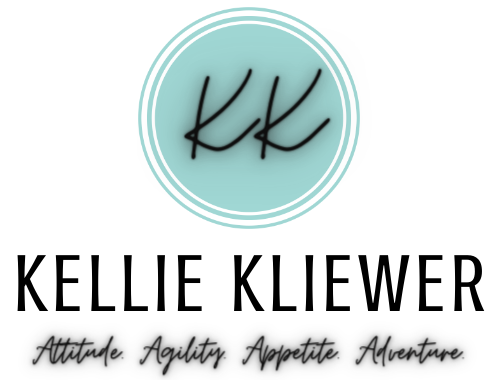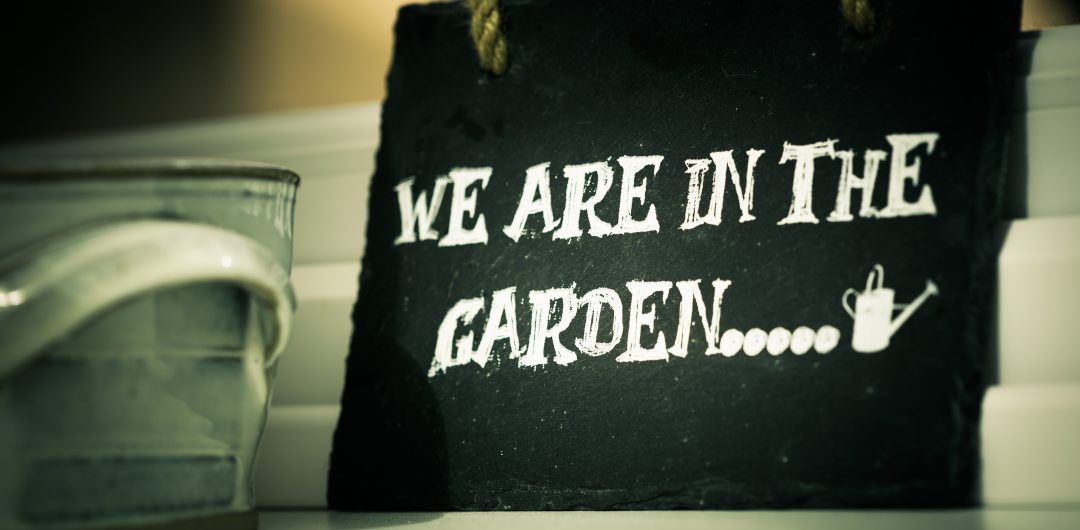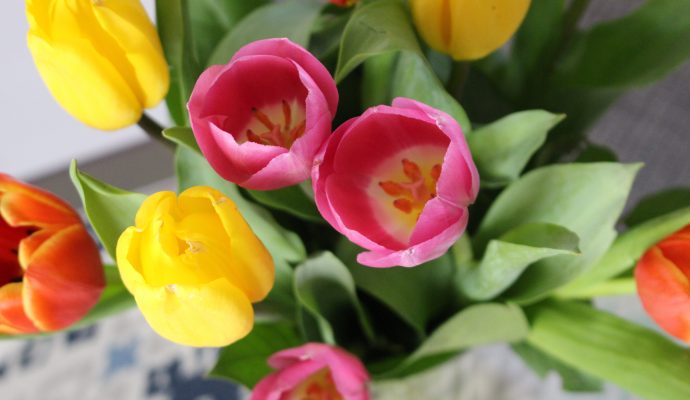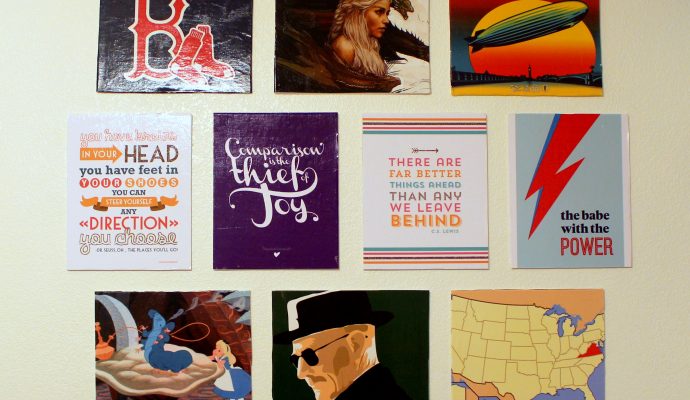*This post may contain affiliate links. This just means that if you buy something listed here, I make a little bit of beer (or dessert) money.
It’s been a couple months since I gave y’all a proper update on our backyard garden, so here’s part two of our summer gardening adventure!
On some of this I will go into more detail later (and offer tips and tricks for anyone also planting a garden) and I’ll compile recommended products at the end as well. All in due time.
We’ve had a lot of fun doing this and watching the little green babies grow so far, and we haven’t even picked our first vegetable! We still have such a long way to go, but our Tuesdays (Sammy’s day off) are made for companion gardening. 🙂
Updates
Layout
In my Backyard Gardening for Beginners – Part 1 post, I introduced the layout we were going for originally. I’m just going to say that after one trip to the garden center and after we got a pricing quote for all the soil required for our plans, we knew we had to reevaluate!
Below is a drawing (obviously not to scale!) of what we ended up with in the backyard.

In case anyone is wondering why I included the amateur drawing of a birdfeeder (a super-detailed hanging square!), I’ll get to that shortly.
After the ridiculous dirt quoting shenanigans, we came home with our first truck full of good quality topsoil and compost, but we decided to also take stock of what we already had in the yard to stretch this purchase out for as long as we could. The boxes in the back of the yard on either side of the tree were to be placed in an area where the previous tenants had been growing their own vegetables before we moved here. There were remnants of lettuces and other veggies freshly re-emerging from the soil, not to mention we spotted a few worms wriggling around in there, so we knew it couldn’t be THAT bad quality of dirt. We decided to till what was already out there and mix it half and half with the good soil that we just brought home. For our first year garden, we had to till by hand with a pitchfork and shovel, but next year we should have something more heavy duty!
It goes without saying that doing all of this has given us plenty of sunshine and exercise for suuuure.
We built our first six raised garden bed boxes, the 4×4′ boxes along the garage and to the right of the tree in the back in the drawing. Sammy attached three PVC hoops per box to form the framework for hanging fencing on to keep critters out.

We lined the bottom of each box with garden fabric to stop weeds from coming through since we likely stirred up a bunch of little weed seeds (the invasive, pesky kind 😉 ) when we tilled the dirt. The fabric can be nailed or stapled directly to the bottom of the boxes, or it can be stretched out on the ground and the boxes placed on top. We chose to staple directly to the boxes.

We then filled them up with the existing dirt from the yard and 5-way compost mixed with Planter’s topsoil that we purchased from the garden center. Also added to the mix was organic fertilizer that I will go into more detail about below.
One piece of Very Important assistance required for moving dirt is a wheelbarrow, and we happen to not own one at the moment. We made do instead with an old cooler equipped with wheels. Fancy, huh? We may have made twice as many trips back and forth from the truck to the beds, but who’s counting?

Once the boxes were in place, I marked off our square foot grid with twine. As a reminder to anyone who missed Part 1, we are using the Square Foot Gardening technique to attempt to make the most out of the space we have. Marking off the feet in the beds allows me to easily plant the allotted number of seeds per square with no confusion.

In case anyone is wondering, yes, that is Saran wrap in the picture above! I had planted seeds for broccoli and onions in this bed and the Saran wrap helps to keep in moisture and heat.
I came to the conclusion though that this works really well in places where wind is nonexistent.
And that’s not in the great outdoors of Colorado, unfortunately. But it would work well for starting seeds indoors!
In the drawing of our garden plans, I also showed six 2×6′ mounds off to the left side of the tree in the back of the yard. Four of the mounds will have netted trellises stretched longways across the middle as well as some kind of fencing around all of them for rabbit/dog prevention, but for now we laugh about how a passerby or a neighbor could quite easily mistake these mounds for fresh graves.

Let’s hope six people don’t go missing around these parts and they have to enlist the aerial policing forces to search for the bodies.
Then we might be in trouble.
Lastly, up next to the house/patio in my drawing above I have two 2×4′ raised beds with trellises. Sammy got lucky and during his last trip to Home Depot found some trellises that were “scraps” and were on sale, so he scooped them up and they fit perfectly in these two beds! I am reserving these guys for melons and cucumbers which are vines that will need to climb.

Oh look, I spy something red and white…
It looks like it’s barking it’s head off…
Any guesses??
Pest Control
Remember the Bunny Brothels from Gardening Part 1? Where we assume the millions of rabbits continue to be conceived day in and day out in our neighborhood, because WHERE THE HELL ELSE could they possibly come from?!
We figured we needed to use garden netting around the beds to keep rabbits from helping themselves to the food we plan to live on for the next few months. The rabbits don’t know that I’m an only child, and I don’t like to share. With rodents, in particular.
Oh, but they will find out soon enough.
The dogs also are nosy and all up in our biz-nass, so the netting helps them stay out too. Just trying to keep our garden hole-free! If you look closely at half my pictures, for instance, one or both of the dogs usually makes an appearance.

Spinach on the left, and broccoli on the right!! Look at our babies go! There are onions sprouting up on the far right that are not visible yet in this picture, but they are there. Sloooooowly but surely.
We just used simple wire twist ties to hold the netting to the PVC hoops, but anything (zipties, clothespins, twine, WHATEVA) can be used to fasten them together. I like the twist ties because they are easy to remove if I wanted to pull the netting up and fasten it to the top of a hoop to get into the box, or I could slide them up the hoop to pull the netting up that way.
Since we are striving to keep our garden organic, I am going to have to resort to natural methods for pest control. I will go into more detail as I put more plants into the ground and actually experience pests, but for right now my pests mostly consist of squirrels, rabbits, and the Georgia-and-Sookie [dog] tag team.
I have been keeping an eye on the beds to pull weeds weekly at the very least. The fabric should help prevent weeds growing from the bottom, but there are still seeds that find their way into the top couple inches of our soil every day.
Sammy attempted to keep tarps over the “mounds” for several weeks to choke out any weeds that may have grown after we stirred up their seeds.
Dixie (my cat) has turned into a ridiculously efficient hunter in her old age, and she brings me dead voles and bunnies every other day. Yaaayyy. I can’t even be mad that she’s powerful in the absence of her front claws and she’s keeping all these critters from eating my food!
BUT, I just wish she’d close their dead eyes before leaving them for me to pick up.
And we now call her the KILLA KITTY.
I also will sprinkle a layer of Diatomaceous Earth over my seedlings once planted every few days to keep any hard bodied insects from eating my plants! This stuff is harmless to humans but will kill anything with an exoskeleton that ingests it.
I’ve seen plenty of other garden tips around this, and will follow up in a later post with what we’ve seen, what works, and what doesn’t in keeping it all organic!
Fertilizing an Organic Garden
The best source of organic fertilizer will always be compost!
The only thing I wish in this regard is that we would have started composting sooner, but there is a first for everything, right?
Every single meal I cook produces excess in the form of vegetable/fruit peels and cut ends, eggshells, coffee rinds, etc. We decided to begin composting a few months back and in those early days, ONE of us (I won’t name any names) was having some minor trouble remembering to separate such goodies so they could be composted. In response, I made a reminder that went on top of the trashcan, complete with a nice list of examples, so we could save our precious rotten trash and make black gold out of it for our future meal ingredients.
It’s a real circle of life, I tell you.
In case anyone made it to the end of the list, yes, apparently urine is something that can be composted. Good nitrogen content, they said. It’ll make your garden grow, they said.
None has made it into my compost bin yet, that I know of.
I’ve got two bins that are now completely full and I can already tell they have come a LONG way since the day I first started them! The key to this as far as I can tell from my reading is to try and keep even ratios between green (plants, vegetables, fruits, grass clippings, etc.) and brown (sticks, dead leaves, detritus, cotton, newspaper, etc.). I ensure that the bins are always moist and in as much full sun as they can get. The more sun on the bins, the warmer they’ll be, and the faster the little microorganisms inside them can work their magic. I try to turn the soil over/stir them up every couple of days and now that they’re full, I will stop adding additional material to them and give them a couple months to “do what they do”.
I keep a smaller bin in the house for materials that arise when I cook.

I make efforts to chop up a lot of the compost before depositing in the bins. The more they are already broken down when you add them to the pile, the faster they will break down into Black Gold. This will also damage any seeds from peppers, squash, tomatoes, etc. and prevent them from growing in your compost bin. For this, I use my large Ninja chopper although I plan to hit up Goodwill this week and find a cheap blender that I don’t care about to do this for me from now on. My Ninja means FAR too much to me to resort to chopping rotten things that sometimes could damage a blade!
Here are the outside bins after a “fresh dump” before we filled them up all the way:
Shocker!!! Georgia made her way into another picture… she couldn’t stay away from the enticing aroma of the stinky things.
The good news is that worms have made their way into our compost bins as well since we drilled holes in both the top and bottom of each for drainage and air flow (and Annelids’ entry!)
And speaking of worms…
You may be wondering why they are so beneficial and why I keep harping on their presence in my garden. In addition to simply moving around, which provides air flow for the microorganisms working their magic on all this stuff, they feed on all the waste and old food and in turn, poop it out in the form of BLACK GOLD.
Seriously.
I’m not one to be fond of poop, but worm poop oddly enough passes the test.
So these guys are wriggling around all day and night making my compost all magical and enchanted and stuff.
And for additional fertilizer, because we just couldn’t get enough of the poop, we also mixed in Earthworm Castings with the soil in our raised beds. Pleasant, right?
Something else we bought because we only had one bag of the worm castings to start, was an organic fertilizer by Dr. Earth that can be mixed in the soil as well.
I’d say our soil quality is ready to GO and produce vegetables of the highest standard!
Let’s hope.
Certified Wildlife Habitat
Two things I’ve got my backyard set up with:
- It’s been certified as a natural wildlife habitat with the National Wildlife Federation
- I’m a Butterfly Hero!
Back to the birdhouse…
In getting certified for the wildlife habitat, I had to fill out a few checklists that required a certain number of items to be checked per page in order to qualify. Some of these things included the presence of trees, soil, grass, flowering plants for butterflies and bees, water, and of course any sort of animal “sanctuary”, to name a few.
My MIL gave me this precious birdhouse a few years back that Sammy had made years ago when he was in elementary school. It’s got huge sentimental value for her and I’ve been meaning to put it out for the longest time, so I got some hooks, wire, and a squirrel baffle and went to work.
The end product is hanging from the corner of the patio, filled with seed, and awaiting its faithful winged visitors!

I still need to get my flower seeds in the ground for my butterflies, but that’s next up on the list. More to come in Part 3!
Past, Present, and Future
Here are some miscellaneous updates and goals/future plans for the garden.
In case anyone remembers and was wondering what the “mystery plant” from Part 1 was, here are the blooms!
They were tulips, after all.
I had another mystery plant but after a Google search, it looks like we’ve got A LOT of raspberries growing out back. I think I’m going to let them be underneath the tree in the back since I can’t plant anything there due to the tree’s roots anyway. They sure do sprawl though, so I’ll have to keep up with them!

Here is an update photo on the seedlings we started indoors, which are tomatoes, cherry tomatoes, tomatillos, green bell peppers, jalapenos, scotch bonnet peppers, cauliflower, Brussel sprouts, sage, catnip, cantaloupe, watermelon, and Mesclun lettuce.
![IMG_1531[1]](http://www.thekuriouskaleidoscope.com/wp-content/uploads/2016/05/IMG_15311.jpg)
One more week until we can put these in the ground outside! I CAN’T FREAKIN’ WAIT to see how they might take off then…
In the ground we have spinach, broccoli, onions, parsnips and carrots, so far. Kale will be put in the ground this week and then I plan to start on the front yard, a barren rock garden that could really use some assistance. I also plan to turn our front beds into flowerbeds – more to come! For now, this is how it looks.
Hmmm, WHAT to do with all this…
I’m thinking I can plant some baby’s breath around the mailbox… flowers in the box along the house… herbs in that circular little bed in the middle… that’s all I’ve got for now.
One more thing I want to add to the “sanctuary” is a DIY birdbath, like any of these birdbath ideas from Self Sufficient Living! Perhaps in the next update.
Lastly, anyone remember my post saying that water barrels were outlawed in Colorado? As of late April 2016, a bill has been written and passed enabling the usage of water barrels and it is only waiting on the governor’s signature to go into effect. Hallelujah! Maybe we can successfully save some water this summer!
Anyone have a garden of their own or any questions/tips for me? Feel free to enter in the comments!
Below is a roundup of the products mentioned in the post in case anyone wants to look into them further (contains affiliate links).
GOOD LUCK!
Recommended Products
- Good quality soil/compost like this Planter’s mix we got from Nick’s Garden Center in Aurora (check your local nursery/garden center to find out who sells bulk soil at the best price!)
- Garden fabric to prevent weeds and soil erosion
- Bird netting to keep critters out of the raised beds
- For soil tilling: a long-handled hand tiller or something more powerful like this Motorized Mini Cultivator
- Top quality (and preferably local!) seeds like we used from Botanical Interests
- Organic fertilizers: Earthworm Castings, Dr. Earth Fertilizer, or fish emulsion
- Good quality bird seed such as Wagner’s containing both fruits and nuts for maximum energy






![IMG_1532[1]](http://www.thekuriouskaleidoscope.com/wp-content/uploads/2016/05/IMG_15321.jpg)


I am so happy you have done so much! I wish I had an intelligent question to put forth to you, but alas….I do not possess that gardening gene that you somehow acquired! Everything looks great, and you have obviously worked hard, both of you, to get the new little seedlings to thrive. I see George is doing her part as well, and of course Killa Kitty. Love it! Keep us posted! Dad has planted our tomatoes and peppers in the self-watering thingy–don’t let my gardening knowledge boggle your brain!!!